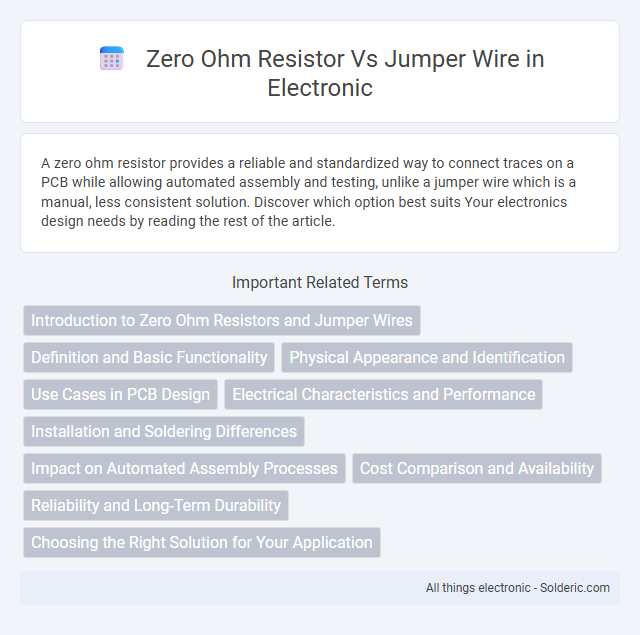A zero ohm resistor provides a reliable and standardized way to connect traces on a PCB while allowing automated assembly and testing, unlike a jumper wire which is a manual, less consistent solution. Discover which option best suits Your electronics design needs by reading the rest of the article.
Comparison Table
| Feature | Zero Ohm Resistor | Jumper Wire |
|---|---|---|
| Definition | Resistor with near-zero resistance used as a PCB jumper | Wire used to connect two points electrically, typically on a breadboard or PCB |
| Resistance | Typically 0 O to a few milliohms | Very low, close to 0 O depending on wire gauge and length |
| Form Factor | Surface-mount or through-hole resistor package | Flexible insulated or bare wire |
| PCB Assembly | Compatible with automated pick-and-place machines | Manual placement required |
| Use Case | Designed to create configurable PCB traces, maintain layout consistency | Used for prototyping, test circuits, or quick connections |
| Reliability | Stable connection, soldered permanently | Less secure, prone to disconnection if not fixed properly |
| Cost | Low cost, but slightly higher than simple wire | Very low cost |
Introduction to Zero Ohm Resistors and Jumper Wires
Zero ohm resistors and jumper wires both serve as connectors on circuit boards, but zero ohm resistors are manufactured components designed to provide a standardized, consistent, and compact connection that can be automated in PCB assembly. You can use a zero ohm resistor to maintain resistor placement protocols while linking circuit traces, whereas jumper wires are flexible, manual connections ideal for quick modifications or prototyping. In electronic design, zero ohm resistors offer reliability with seamless integration, while jumper wires offer versatility during testing or circuit adjustments.
Definition and Basic Functionality
A zero ohm resistor is a fixed resistor with a near-zero resistance value used primarily for PCB trace bridging and configuration settings, acting as a convenient electrical jumper with precision placement. A jumper wire, by contrast, is a simple conductor that creates a direct electrical connection between two points without any resistance. Your choice depends on the need for automated assembly compatibility and circuit design clarity, where the zero ohm resistor provides improved soldering reliability and ease of testing compared to using jumper wires.
Physical Appearance and Identification
Zero ohm resistors resemble standard resistors in size and shape but feature a single black or brown band indicating zero resistance, making them easy to identify in automated assembly processes. Jumper wires are flexible, insulated wires often with exposed, solderable ends, distinguishing them physically from the rigid, component-like zero ohm resistors. Your ability to quickly differentiate these components ensures accurate circuit assembly and troubleshooting.
Use Cases in PCB Design
Zero ohm resistors serve as configurable jumpers in PCB design, enabling signal routing flexibility without requiring layout changes, especially useful during prototyping or mass production adjustments. Jumper wires are typically used for manual corrections or repairs on populated boards where immediate path re-routing is necessary without redesigning the PCB. Both components provide electrical continuity, but zero ohm resistors integrate seamlessly into automated assembly processes, maintaining board reliability and reducing manufacturing costs.
Electrical Characteristics and Performance
Zero ohm resistors provide consistent mechanical and electrical performance with low resistance typically around 0.001 to 0.005 ohms, ensuring minimal signal loss and reliable circuit continuity. Jumper wires offer flexibility and ease of manual connections but can introduce higher resistance and potential signal interference due to variable contact quality. Zero ohm resistors excel in automated PCB assembly by maintaining circuit integrity, whereas jumper wires are better suited for prototyping and troubleshooting where quick reconfiguration is needed.
Installation and Soldering Differences
Zero ohm resistors simplify PCB installation by allowing automated placement machines to handle them like standard resistors, enhancing manufacturing efficiency and accuracy. In contrast, jumper wires require manual insertion and soldering, increasing assembly time and the risk of inconsistent connections. The soldering process for zero ohm resistors ensures reliable mechanical and electrical contact with standardized footprints, whereas jumper wires may introduce variability due to flexible leads and non-standardized mounting points.
Impact on Automated Assembly Processes
Zero ohm resistors simplify automated assembly by allowing machines to place them just like standard resistors, enabling efficient circuit customization without altering pick-and-place programs. Jumper wires often require manual placement or additional process steps, increasing assembly time and potential for errors. Choosing a zero ohm resistor enhances your manufacturing throughput and consistency in automated PCB assembly lines.
Cost Comparison and Availability
Zero ohm resistors are generally more expensive than jumper wires due to their standardized manufacturing process and packaging for automated assembly. Jumper wires, being simple insulated wires, are widely available and cost-effective, especially for prototype and manual wiring tasks. Availability of zero ohm resistors is high in electronics component distributors, but jumper wires remain more accessible in general electronics stores and hobbyist kits.
Reliability and Long-Term Durability
Zero ohm resistors offer enhanced reliability and long-term durability compared to jumper wires due to their standardized manufacturing process and robust materials, which ensure consistent electrical performance under various environmental conditions. Unlike jumper wires, zero ohm resistors maintain strong mechanical stability and resist oxidation and wear over time, reducing the risk of intermittent connections or failures in critical electronic circuits. Their compact size and compatibility with automated assembly lines further contribute to reduced assembly errors and improved overall circuit longevity.
Choosing the Right Solution for Your Application
Zero ohm resistors provide a standardized, compact solution for circuit board trace bridging, ensuring consistent impedance and compatibility with automated pick-and-place assembly. Jumper wires offer flexibility for manual modifications or prototyping but can introduce variability and potential interference in high-frequency or high-density designs. Selecting between the two depends on manufacturing scale, electrical performance requirements, and the need for reliability in the final product.
Zero ohm resistor vs jumper wire Infographic

 solderic.com
solderic.com